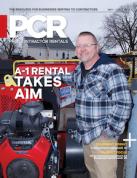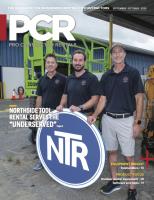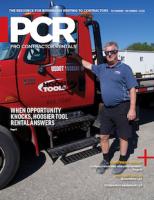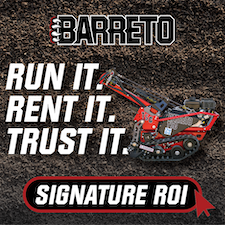Service Tips: Lead-acid battery maintenance
Consistent flooded lead-acid battery maintenance boosts profits.
by John Bear and Thomas Weiss
Scissor lifts, boom lifts and floor equipment are generally powered by flooded lead-acid batteries. When batteries are improperly charged, watered or maintained, the equipment slows down or goes down. Work stalls, frustration mounts and costs escalate. What’s more, if the neglect is severe – and it often is – it can destroy these batteries or significantly reduce their lifespan. This can cost equipment rental businesses thousands of dollars annually.
Two-pronged approach
To alleviate these problems, equipment rental businesses must take a two-pronged approach. They must care for the batteries between rentals and make sure their longer-term renters – those who rent for a few days or more – maintain the batteries in accordance with manufacturer recommendations. Always consult manufacturer maintenance recommendations before performing maintenance on batteries; effective care and maintenance can extend the life of batteries and reduce costs.
Fortunately, the maintenance requirements for flooded lead-acid batteries are generally the same, regardless of the manufacturer. Further, most equipment comes with an automatic onboard charger programmed to meet the parameters of the battery. The technician plugs in the machine and the battery charges properly, without over- or under-charging.
That does not mean, however, that all flooded lead-acid batteries are the same. Do your due diligence and partner with a U.S.-based manufacturer with years of experience, a proven service department and a national network of distributors.
In-house maintenance
To reduce expensive callbacks, make sure equipment batteries are fully charged and ready to run before each rental. Once the equipment is returned, have a technician inspect it for damage and check that it is operating and has been charged and watered. A dead charge reading shows the battery has not been charged and dry cells indicate that it has not been watered.
Your response to this type of neglect will depend on your relationship and agreement with the customer. In any case, inform the renter that the batteries have not been properly maintained and explain how that affects the life and performance of the equipment. Make sure contractors understand that they, too, have a vested interest in keeping the batteries in good working order.
Cleaning tips
Using personal protective equipment (PPE), such as gloves, insulated tools and safety goggles, and with the battery disconnected from equipment and chargers, the service technician should inspect the battery and clean the top and exposed areas following manufacturer instructions. Generally, this type of cleaning is done with baking soda, water and a non-metallic brush with the technician making sure the terminals and connectors are free of dirt and corrosion. Rinse with water, dry with a clean cloth and apply an anti-oxidation terminal protector.
The connections between the battery and cables should be clean and torqued to manufacturer specifications because grime and loose contacts can cause the battery to discharge. Check the electrolyte level to make sure it covers the plates but should not be watered to maximum capacity before charging.
Charging and watering
Bring the battery to full charge as soon as possible after the equipment is returned. Do not release a partially charged battery for rental, and never let the state of charge (SOC) fall below 70 percent.
After the battery is fully charged, verify that the charger is working effectively by using a hydrometer to perform a specific gravity test to see if the results match your battery’s requirements. Check the water level after charging and add distilled or deionized water if needed.
Reputable battery manufacturers, including Trojan, train rental house technicians to maintain batteries through its technical solutions department or master distributor network.
Storing lead-acid batteries
If the equipment will be idle for a few weeks, give it a full charge, store it in an indoor environment and check the voltage every four to six weeks. If the SOC falls below 70 percent, charge the battery. Do not store equipment with flooded lead-acid batteries in areas with temperatures below freezing or above 122F.
Communicating with renters
A larger challenge is making sure renters understand the importance of maintaining the batteries and know what is required of them. Some equipment rental businesses offer battery maintenance training to their long-term renters. This can be a cost-effective investment.
Tell renters that good battery maintenance is important to their bottom line. Proper maintenance will keep the machines up and running and help them avoid downtime, hassles and increased labor costs.
Make sure rental counter attendants, delivery drivers and other front-line employees routinely explain the importance of proper battery maintenance before releasing equipment.
To maximize their rental dollars, equipment renters should train their crews to check and charge the battery every day and check the water frequently. Encourage contractors to establish a daily two-step routine using appropriate PPE to ensure continued maintenance
First step: the last person who uses the equipment should check the battery to make sure connections are clean and tight, do any necessary cleaning and plug in the charger, making sure the battery is charging before leaving.
Second step: The first person who uses the equipment after it has been charged should make sure the battery has water by removing the cap and checking the fill line. Warn them not to overfill the cells. Overwatering can cause battery damage, just as under-watering can cause damage.
Watering is by far the biggest problem with renters and flooded lead-acid batteries. Many don’t realize the importance of watering or simply neglect to water the batteries. Batteries that are allowed to run dry are destroyed and must be replaced. This disrupts the contractor’s schedule and takes a bite out of the rental center’s budget.
If a renter is experiencing problems with a battery, he or she should ensure that the charger is working properly. A battery that is fully charged but runs for just a few minutes often indicates a problem with the charger. If that occurs, the user should charge the battery, then use a hydrometer to verify the specific gravity, or call the rental company to send a technician out to check the charger.
Improve renter compliance with free battery maintenance posters
Help service technicians and renters maintain flooded lead-acid batteries and protect the equipment investment with a free poster from Trojan Battery Co. LLC that includes step-by-step maintenance guidelines in English and Spanish. Visit https://www.trojanbattery.com/wp-content/uploads/2021/11/Trojan-Battery-Maintenance-Guide-TRJN0110-2019.pdf. Download the file and take or send it to your local printer for printing. Hang one in your shop and distribute others to renters.
Editor’s note: John Bear is director of product engineering and Thomas Weiss senior manager of national accounts at Trojan Battery Company, LLC.
This article aoriginally appeared in the January-February 2022 issue of Pro contractor Rentals magazine. ©Urbain Communications LLC. All rights reserved.










